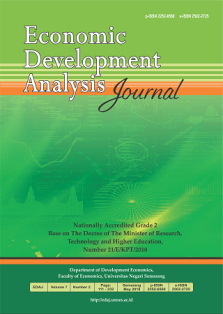Determinants of Income Inequality in a Time Perspective in Indonesia
Abstract
The development orientation which is more dominant on growth, has been impaled to widen the inequality gap. The purpose of this study is to analyze the short-term and long-term effects of several determinants of income in Indonesia during 1998-2021. Data sourced from the World Bank in a time series format. The study method uses descriptive quantitative analysis with the Error Correction Model approach. The Gini index is used as the dependent variable, while the independent variables include the ratio of the work force graduates above senior high school, urban population growth, the agricultural sector, haunting, and fisheries, and per capita GDP growth. The stationarity test results show that stationarity occurs in the first derivative data. Cointegration test results using the Engle-Granger method show that the model built has cointegration. The results of the long-term regression show that two variables have a significant effect on the Gini index, namely the ratio of the work force graduates above senior high school which has a positive effect, and the urban population growth rate which has a negative effect. In the short term, the ratio of the work force graduates above senior high school contributes significantly to the increase in the Gini index. Meanwhile, other predictor variables have no significant effect on the Gini index in Indonesia. The lack of support from the agricultural sector in pushing the Gini index down, and the positive role of the highly educated work force, reflects the ongoing development process which still seems exclusive.


